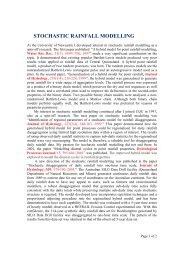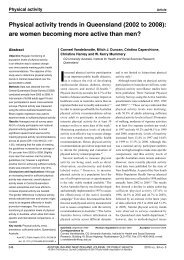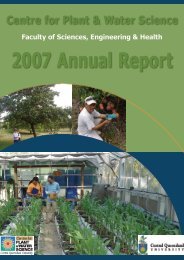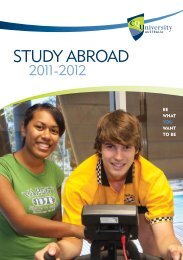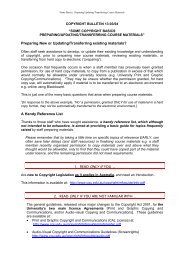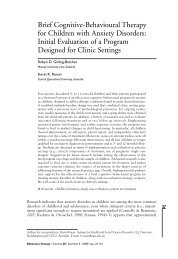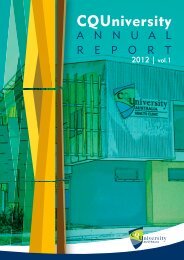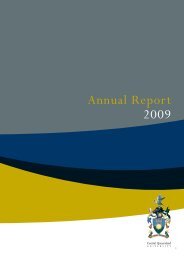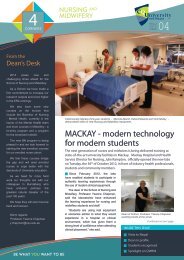Centre for Plant & Water Science - Central Queensland University
Centre for Plant & Water Science - Central Queensland University
Centre for Plant & Water Science - Central Queensland University
Create successful ePaper yourself
Turn your PDF publications into a flip-book with our unique Google optimized e-Paper software.
<strong>Centre</strong> <strong>for</strong> <strong>Plant</strong> & <strong>Water</strong> <strong>Science</strong> 2008 Annual Report<br />
CHARACTERISATION AND ASSESSMENT OF DRYNESS (GELLING)<br />
DEFECT OF MANDARIN FRUIT<br />
SUMMARY<br />
This represents the third year of a three-year funded activity within a larger DPI led, HAL<br />
funded project “Management of Internal Dryness of Imperial Mandarin”. In previous work<br />
we have obtained inconsistent results using near infrared spectroscopy (NIRS) technique to<br />
detect the gelling disorder in Imperial mandarin. In the year 2007/ 08, we aimed to extend<br />
NIRS work <strong>for</strong> further confirmation of the inconclusive results obtained in the previous<br />
years. In this current year other non-invasive techniques (nuclear magnetic resonance,<br />
computed tomography – X ray; on-line transmission X ray, firmness measurements by<br />
accelerometer, acoustic frequency and acoustic velocity) were also explored. Some more<br />
work was also extended <strong>for</strong> the characterisation of the gelling disorder and a confirmative<br />
trial “effect of long term storage on gelling defect” was undertaken.<br />
In previous years we had indicated that an optical method could be used to used to<br />
differentiate mandarin fruit with a dryness (‘gelling’) defect if the fruit were in ‘breaking<br />
green stage’ (with defect fruit being less mature than normal fruit). In the current year of<br />
activity, we were unable to validate this result. We had also reported no difference between<br />
interactance and transmittance optical geometries. Given that dryness-defect-affected-tissue<br />
appears white (i.e. is highly light scattering), it is reasonable to postulate that a transmission<br />
geometry should be advantageous. However, this was not demonstrated in a repeat<br />
experiment (interactance vs transmission geometries), nor in a laser scattering trial, with<br />
intact fruit. These results are attributed to the influence of the skin and flavedo.<br />
Other non-invasive techniques (nuclear magnetic resonance, computed tomography – X ray;<br />
on-line transmission X ray, firmness measurements by accelerometer, acoustic frequency<br />
and acoustic velocity) were also used unsuccessfully used to differentiate defect from<br />
normal fruit. These results were attributed to the lack of chemical differences, density<br />
difference and the interference of the skin, respectively.<br />
Given an indication in 06/07 that the severity of the defect increased in fruit in long term<br />
storage, a 14 week storage trial was established in 07/08 to investigate this possibility. The<br />
results did not support the hypothesis that defect severity increased during storage. Except in<br />
severely affected fruit, affected fruit were not different in water content relative to control<br />
fruit. Defect level was very poorly correlated to other measured fruit attributes (juice ºBrix,<br />
peel weight).<br />
In our previous report, we provided preliminary results that in mature affected fruit, juice<br />
sacs were characterised by the presence of numerous small cells, located to the outside of the<br />
juice sac. It was postulated that this defect is established early in fruit growth as juice sac<br />
cell division presumably ends early in fruit development. This observation was confirmed<br />
using resin embedded sections examined using light and transmission electron microscopy,<br />
and cryoplaned frozen specimens, examined using scanning electron microscopy. Further, in<br />
severely affected tissue, cell wall thickness was increased.<br />
A B C<br />
32





